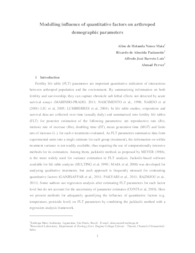Modelling influence of quantitative factors on arthropod demographic parameters.
Modelling influence of quantitative factors on arthropod demographic parameters.
Author(s): MAIA, A. de H. N.; PAZIANOTTO, R. A. A.; LUIZ, A. J. B.; PERVEZ, A.
Summary: Fertility life table (FLT) parameters are important quantitative indicators of interactions between arthropod population and the environment. By summarizing information on both fertility and survivorship, they can capture chronicle sub lethal effects not detected by acute survival assays (MARINHO-PRADO, 2011; NASCIMENTO et al., 1998; NARDO et al (2001) LIU et al, 2005; LUMBIERRES et al, 2004). In life table studies, oviposition and survival data are collected over time (usually daily) and summarized into fertility life tables (FLT) for posterior estimation of the following parameters: net reproductive rate (Ro), intrinsic rate of increase (Rm), doubling time (DT), mean generation time (MGT) and finite rate of increase ( ), for each o treatments evaluated. As FLT parameters summarize data from experimental units into a single estimate for each group (treatment), the information on within treatment variance is not readily available, thus requiring the use of computationally intensive methods for its estimation. Among them, jackknife method, as proposed by MEYER (1986), is the most widely used for variance estimation in FLT analysis. Jacknife-based software available for life table analysis (HULTING et al, 1990 ; MAIA et al, 2000) was developed for analysing qualitative treatments, but such approach is frequently misused for contrasting quantitative factors (GANJISAFFAR et al., 2011; PAKYARI et al., 2011; RAZMJOU et al., 2011). Some authors use regression analysis after estimating FLT parameters for each factor level but do not account for the uncertainty of parameter estimates (CONTI et al, 2010). Here we present methods for adequately quantifying the influence of quantitative factors (e.g. temperature, pesticide level) on FLT parameters by combining the jackknife method with a regression analysis framework.
Publication year: 2013
Types of publication: Paper in annals and proceedings
Unit: Embrapa Environment
Observation
Some of Embrapa's publications are published as ePub files. To read them, use or download one of the following free software options to your computer or mobile device. Android: Google Play Books; IOS: iBooks; Windows and Linux: Calibre.
Access other publications
Access the Agricultural Research Database (BDPA) to consult Embrapa's full library collection and records.
Visit Embrapa Bookstore to purchase books and other publications sold by Embrapa.

